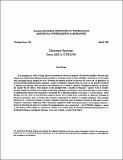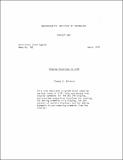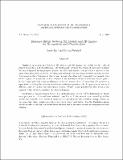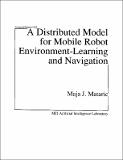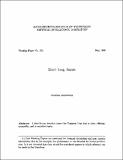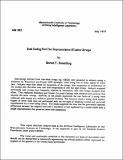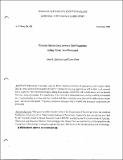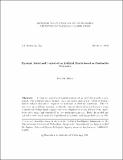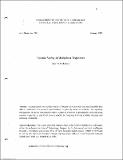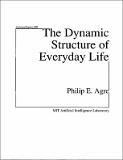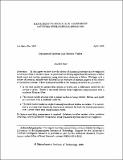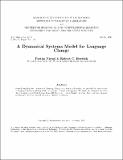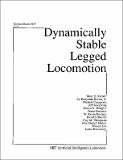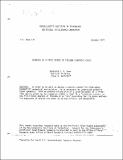Browsing Artificial Intelligence Lab Publications by Title
Now showing items 426-445 of 1835
-
Discovery Systems: From AM to CYRANO
(MIT Artificial Intelligence Laboratory, 1987-03)The emergence in 1976 of Doug Lenat's mathematical discovery program AM [Len76] [Len82a] was met with suprise and controversy; AM's performance seemed to bring the dream of super-intelligent machines to our doorstep, with ... -
Disparity Gradients and Depth Scaling
(1989-09-01)The binocular perception of shape and depth relations between objects can change considerably if the viewing direction is changed only by a small angle. We explored this effect psychophysically and found a strong depth ... -
Display Functions in LISP
(1970-03-01)This note describes a system which compiles various forms of LISP lists and arrays into display commands for the DEC 340 display, and provides supporting functions for scaling, for moving elements in a display, for pot ... -
Dissociated Dipoles: Image representation via non-local comparisons
(2003-08-13)A fundamental question in visual neuroscience is how to represent image structure. The most common representational schemes rely on differential operators that compare adjacent image regions. While well-suited to encoding ... -
Distance Metric Between 3D Models and 3D Images for Recognition and Classification
(1992-07-01)Similarity measurements between 3D objects and 2D images are useful for the tasks of object recognition and classification. We distinguish between two types of similarity metrics: metrics computed in image-space (image ... -
A Distributed Model for Mobile Robot Environment-Learning and Navigation
(1990-05-01)A distributed method for mobile robot navigation, spatial learning, and path planning is presented. It is implemented on a sonar-based physical robot, Toto, consisting of three competence layers: 1) Low-level navigation: ... -
Does Vision Need a Special-purpose Language?
(MIT Artificial Intelligence Laboratory, 1973-09)This paper briefly discusses the following questions: What are the benefits of special-purpose languages? When is a field ready for such a language? Are any parts of our current vision research ready? -
Don't Loop, Iterate
(MIT Artificial Intelligence Laboratory, 1990-05)I describe an iteration macro for Common Lisp that is clear, efficient, extensible, and in excellent taste. -
The Dream of a Lifetime: A Lazy Scoping Mechanism
(1979-11-01)We define a "rack", a data abstraction hybrid of a register and a stack. It is used for encapsulating the behavior of the kind of register whose contents may have an extent which requires that it be saved during the ... -
Dual Coding and the Representation of Letter Strings
(1977-07-01)Sub-strings derived from four-letter strings (e.g. ABCD) were presented to subjects using a variation on Bransford and Franks' (1971) paradigm. Each strins was in either upper or lower case. Subjects were then tested ... -
Dynamic Graphics Using Quasi Parallelism
(1978-06-01)Dynamic computer graphics is best represented as several processes operating in parallel. Full parallel processing, however, entails much complex mechanism making it difficult to write simple, intuitive programs for ... -
Dynamic Interactions Between Limb Segments During Planar Arm Movement
(1981-11-01)Movement of multiple segment limbs requires generation of appropriate joint torques which include terms arising from dynamic interactions among the moving segments as well as from such external forces as gravity. The ... -
Dynamic Model and Control of an Artificial Muscle Based on Contractile Polymers
(1991-11-01)A dynamic model and control system of an artificial muscle is presented. The artificial muscle is based on a contractile polymer gel which undergoes abrupt volume changes in response to variations in external conditions. ... -
Dynamic Scaling of Manipulator Trajectories
(1983-01-01)A fundamental time-scaling property of manipulator dynamics has been identified that allows modification of movement speed without complete dynamics recalculation. By exploiting this property, it can be determined ... -
The Dynamic Structure of Everyday Life
(1988-10-01)Computational theories of action have generally understood the organized nature of human activity through the construction and execution of plans. By consigning the phenomena of contingency and improvisation to ... -
Dynamical Systems and Motion Vision
(1988-04-01)In this paper we show how the theory of dynamical systems can be employed to solve problems in motion vision. In particular we develop algorithms for the recovery of dense depth maps and motion parameters using state ... -
A Dynamical Systems Model for Language Change
(1995-12-01)Formalizing linguists' intuitions of language change as a dynamical system, we quantify the time course of language change including sudden vs. gradual changes in languages. We apply the computer model to the historical ... -
Dynamically Stable Legged Locomotion (September 1985-Septembers1989)
(1989-09-01)This report documents our work in exploring active balance for dynamic legged systems for the period from September 1985 through September 1989. The purpose of this research is to build a foundation of knowledge that ... -
The Dynamicist's Workbench: I Automatic Preparation of Numerical Experiments
(1987-05-01)The dynamicist's workbench is a system for automating some of the work of experimental dynamics. We describe a portion of our system that deals with the setting up and execution of numerical simulations. This part of ... -
Dynamics of a Three Degree of Freedom Kinematic Chain
(1977-10-01)In order to be able to design a control system for high-speed control of mechanical manipulators, it is necessary to understand properly their dynamics. Here we present an analysis of a detailed model of a three-link ...

